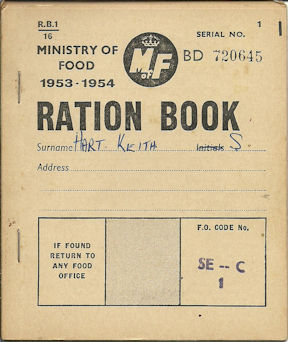World War II Ration Books
At the outset of the Second World War, when the civilian
population of Britain was fifty million, the country imported around fifty-five
million tons of food a year. It was one of the principal strategies of the
Germans to attack shipping bound for Britain, restricting British industry and
potentially starving the nation into submission.
Rationing officially
began on 8th January, 1940 and was introduced to ensure a fair distribution of
food. Ration books were issued to every person and had to be stamped by a local
shopkeeper when the goods were collected.
The weekly ration varied from
month to month as foods became more or less plentiful. The diet was designed to
supply approximately 2,300 calories a day for each adult, with manual labourers
and miners receiving extra rations. Babies, pregnant women and sick people were
also given additional rations of milk, orange juice and cod liver oil and extra
milk was available to invalids.
 A typical ration
for one adult per week was: A typical ration
for one adult per week was:
one fresh egg
50g (2oz) butter
100g
(4oz)margarine
50g (2oz) tea
25g (1 oz) cheese
225g (8oz)
sugar
100g (4oz or 4 rashers) bacon
3 pints (1800ml) milk
occasionally
dropping to 2 pints (1200ml)
Meat to the value of 1s 2d (around 6p today)
was also included
There was a monthly points system in operation, too,
with each person allowed 24 points every four weeks. The more expensive the
item, the more points it cost. Cheaper cuts of meat, therefore, became popular
and allowed people to save their rationing points for other items such as
cereals and tinned food.
Long queues outside shops became the norm - if
there was a long line of people waiting, it meant there was something to buy,
though queuing customers had no idea what. In 1946, when food was just as short
as during the preceding years, bread was added to the ration and the sweet
ration was halved.
The one food item that wasn't rationed was vegetables
and the population was encouraged to grow their own and their own fruit. The
'Dig for Victory' campaign started in October 1939 and called for every man and
woman to keep an allotment. Lawns and flower-beds were turned into vegetable
plots. Chickens, rabbits, goats and pigs were reared in town parks and gardens.
A huge number of allotments came into being, 30,000 in London alone with 600 of
them in the royal parks. The gardens of Kensington Palace were turned over to
cabbages.
The government made strenuous efforts to keep morale high. For
the first time school meals were offered to children, as mothers were working
extremely long hours to help the war effort. And the Ministry of Food was set
up to help families make the most of their rations. It provided recipes and
advice, demonstrating, for example, how to use powdered eggs and be creative
with what was available. Woolton Pie, named after Lord Woolton, was perhaps the
most well-known recipe and went on the menu in March 1941. The pie was a mix of
stewed swede, turnip and cauliflower beneath a lid of short crust pastry or
mashed potato. Woolton Pie being the most hated meal.
Restaurants
allowed diners to eat off the ration and provided better food than could be
bought in shops (luxury foods escaped regulation). For people who were unable
to afford such meals, this could be a source of resentment. As a counter, an
order came into force in March, 1941, capping the price of a three course
restaurant dinner at 5s. 0d.
Food was not alone in being rationed.
Petrol consumption was severely limited and so, too, was the size of
newspapers. At first they were reduced to sixty per cent of their pre-war paper
consumption, but by 1945 this had dropped to twenty-five per cent. Wrapping
paper for most goods was prohibited. Furniture design became simpler and
plainer during the period, while items such as razor blades, baby bottles and
frying pans, although not rationed, were almost impossible to
buy.
Clothing, too, was difficult. Initially each adult was given 66
points for clothing per year but this was cut to 48 in 1942, 36 in 1943 and 24
in 1945. To get some idea how difficult it became, in 1945 an overcoat (wool
and fully lined) took 18 coupons; a man's suit 26-29 and women's shoes 7. Lace
and frills were soon banned from knickers to save on material, and in 1942
austerity measures were introduced to restrict the number of buttons, pockets
and pleats on clothes. Second hand clothing avoided points, but their price was
fixed. Shoes were in such short supply that nurses' work shoes are kept for
years, held together with sticking plaster.
Clothes rationing finally
ended on 15 March, 1949, but other restrictions remained. Confectionery came
off ration in February, 1953 and sugar in September of the same year. But it
was not until 4 July, 1954 that meat and all other food rationing disappeared -
years after the war had ended. |
 A typical ration
for one adult per week was:
A typical ration
for one adult per week was: